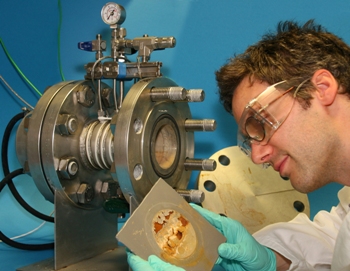Internal coatings in the different sections of oil treatment plants are subjected to a variety of stresses. By conducting comparative tests, researchers are analyzing which materials are best suited to each individual section.
 Fitness test failure! Examining a coating sample after a resistance test has been conducted in the Atlas cell. © Fraunhofer IWM
Fitness test failure! Examining a coating sample after a resistance test has been conducted in the Atlas cell. © Fraunhofer IWM
The internal coatings of oil production facilities have to withstand multiple stresses: aggressive chemical substances, high temperatures and pressures, as well as sand and stone particles abrading the walls of tanks and pipelines. Over time, this causes the applied linings to degrade, thus facilitating corrosion of underlying steel structures. This is why the coatings of tanks, separators, and pipelines must be renewed on a regular basis. However, how long the material “holds” depends on the individual levels of stress it is exposed to. A single coating is not necessarily equally well-suited to every application. But until now, there is a lack of systematic analysis of the materials available on the market. Such a comparative analysis would allow plant operators to assess a material’s suitability for different types of stress.
Researchers at the Fraunhofer Institute for Mechanics of Materials IWM are now working to close this gap. In a project sponsored by the DGMK German Society for Petroleum and Coal Science and Technology, researchers in Freiburg have come up with a test program that assesses corrosion resistance in different stress scenarios. The program closely replicates real treatment conditions. “In the different sections of the plant, the coating material is exposed to completely different conditions,” says Dr. Matthias Gurr of the IWM. For instance, sand or stone particles are generally present in the extracted mix in the immediate vicinity of the drilling hole. In this part of the plant, it is especially important that the coating is able to withstand the mechanical stress caused by abrasion. However, chemical factors also put the material under stress, among them saline solutions such as the reservoir water that is pumped out of the ground with the crude oil during extraction. To effectively protect the underlying steel surface, coatings that are exposed to this solution require high chemical resistance and a good level of impermeability. “The saline solution is separated from the oil in the separator later on,” says Gurr. “For plant sections that are located downstream of the separator, resistance to the saline solution is, in most instances, not as important.”
Taking the „cold wall“ effect into account
To assess the corrosion resistance of coatings in a laboratory environment, the re- searchers apply a number of different tests. In the autoclave test, for instance, researchers put a material sample together with a medium – such as an oil-saline mix – in a gas-tight container and expose it to temperatures up to 150 degrees Celsius. For most materials, the critical temperature limit for heightened susceptibility to corrosion is far lower. While the test is state of the art, not all conditions that actually occur in a treatment plant can be simulated. For instance, in containers that do not have additional insulation, thermally induced stress and the effects of condensation (the so-called “cold wall” effect) also have an influence on materials, as there can be stark differences in temperature between the container’s exterior and interior walls. To create such a difference in temperature in laboratory conditions, the researchers use special Atlas cells. These comprise a medium-filled steel cell which is sealed by presssing coated samples onto its open ends. “As a result, the coating becomes part of the container wall,” says Gurr. While the medium is heated up on the inside of the cell, the researchers can use a cooling circuit to regulate the ambient temperature downward.
The experts are compiling their results in a comprehensive table. With its help, plant operators will one day be able to find out at a single glance which materials are best suited for specific stress parameters. The researchers aim to test coating materials under real conditions at a treatment plant, and talks are currently underway with several industry partners from the project consortium. Gurr and his team are hoping to have the initial results in about two years. “Correlating our lab tests with the field experiments in this way would form an important basis for concrete forecasts about the life cycle of coating systems in the future,” says Gurr.